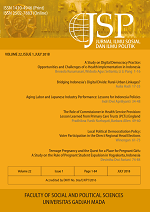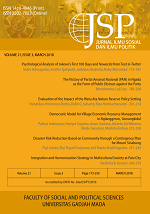Gender Determinant on Multidimensional Poverty Index: Evidence from Indonesia
Thomas Soseco(1), Isnawati Hidayah(2*), Ayu Dwidyah Rini(3)
(1) Universitas Negeri Malang, Indonesia
(2) ROTASI Institute (Institute for Rural Development and Sustainability), Indonesia; Department of Economic and Law, Sapienza University of Rome, Italy
(3) Universitas Trilogi, Indonesia
(*) Corresponding Author
Abstract
Poverty measurement from a non-monetary aspect is needed as low-income individuals are not always multidimensionally poor, and vice versa. The focus should also be on the gender determinant potentially related to the inequality in wage, labour market, and the return of education, which can influence the household’s ability to achieve a higher standard of living and alleviate poverty. This paper discovers the contribution of gender determinants to multidimensional poverty conditions in Indonesia. This paper used logit estimation using National Socioeconomics Survey (Susenas) 2018. The data show that approximately 10% of the Indonesian population is considered vulnerably poor, and severely poor is 3%. The vulnerably and severely poor individuals are mostly measured from years of schooling, health insurance ownership, and assets ownership. Moreover, we find that variables of household size, dependency ratio, and household head age are the better explanators of poverty’s vulnerability. However, those variables cannot explain severe poverty among female- and male-headed households, even though female-headed households are more prone to falling into poverty situations. Then, the decomposition results show that our selected variables explain the probability of being vulnerable poor. However, the probability of being severely poor is largely determined by unobservable behaviour domination not included in the study.
Keywords
Full Text:
PDFReferences
Alkire, S., & Foster, J. (2007). Counting and Multidimensional Poverty Measurement. Retrieved from https://ophi.org.uk/working-paper-number-07/
Alkire, S., & Foster, J. (2011). Counting and multidimensional poverty measurement. Journal of Public Economics, 95(7-8), 476-487.
Alkire, S., & Santos, M. E. (2014). Measuring Acute Pov erty in the Dev eloping World: Robustness and Scope of the Multidimensional Poverty Index. World Development, 59, 251-274. https://doi.org/10.1016/j.worlddev.2014.01.026
Badan Pusat Statistik. (2018). Persentase pendudukmiskinMaret2018turunmenjadi 9,82 persen. Retrieved from https://www. bps.go.id/pressrelease/2018/07/16/1483/persentase-penduduk-miskin-maret-2018-turun-menjadi-9-82-persen.html
Badan Pusat Statist ik. (2020). Proporsi Penduduk Yang Hidup Di Bawah Garis Kemiskinan Internasional (1,90 USD Per Hari) Retrieved from https://bps.go.id/indicator/23/1471/8/proporsi-penduduk-yang-hidup-di-bawah-garis-kemiskinan- internasional-1-90-usd-per-hari-.html
Badan Pusat Statistik. (2021). Jumlah Penduduk Miskin, Persentase Penduduk Miskin dan Garis Kemiskinan, 1970-2017. Retrieved from https://www.bps.go.id/statictable/2014/ 01/30/1494/jumlah-penduduk-miskin-persentase-penduduk-miskin-dan-garis-kemiskinan-1970-2017. html
Bauer, T., Göhlmann, S., & Sinning, M. (2007). Gender differences in smoking behavior. Health Economics, 16(9), 895-909. https:// doi.org/10.1002/hec.1259
Budig, M. J., & Hodges, M. J. (2010). Differences in disadvantage: Variation in the motherhood penalty across white women’s earnings distribution. American Sociological Review, 75(5), 705-728.
Cameron, A. C., & Trivedi, P. K. (2005). Microeconometrics: Methods and Applications. Cambridge: Cambridge University Press.
Drake, C. (1981). The Spatial Pattern of National Integration in Indonesia. Transactions of the Institute of British Geographers, 6(4), 471-490. https://doi.org/10.2307/621880
Espinoza-Delgado, J., & Klasen, S. (2018). Gender and multidimensional poverty in Nicaragua: An individual based approach. World Development, 110, 466-491.
Hardin, J. W., & Hilbe, J. M. (2007). Generalized linear models and extensions. College Station, Texas: Stata Press.
Jordan, B. (1996). A theory of poverty and social exclusion. Oxford: Polity Press.
Kakwani, N., & Silber, J. (Eds.). (2008). Quantitative approaches to multidimensional poverty measurement. Hampshire: Palgrave Macmillan.
Killewald, A., & Bearak, J. (2014). Is the motherhood penalty larger for low- wage women? A comment on quantile regression. American Sociological Review, 79(2), 350-357.
Kontan. (2021). Menyimak strateg i BPJS Kesehatan mengejar target kepesertaan 95% di 2019. Retrieved from https://keuangan.kontan.co.id/news/menyimak- strategi-bpjs-kesehatan-mengejar-target- kepesertaan-95-di-2019
Nazara, S., Hewings, G. J. D., & Sonis, M. (2006). An exploratory analysis of hierarchical spatial interaction: the case of regional income shares in Indonesia. Journal of Geographical Systems, 8(3), 253-268. https://doi.org/10.1007/s10109-005-0016-3
Ndinda, C., & Ndhlovu, T. P. (2018). Gender, poverty and inequality: exploration from a transformative perspective. Journal of International Women's Studies, 19(5), 1-12.
Oxford Poverty and Human Development Initiative. (2017). Indonesia Country Briefing [Press release]. Retrieved from http://www.ophi.org.uk/multidimensional- poverty-index/mpi-country-briefings/
Pacifico, D., & Poege, F. (2017). Estimating measures of multidimensional poverty with Stata. The Stata Journal, 17(3), 687-703.
Sen, A. (1999). Development as freedom. New York: Oxford University Press.
Sinning, M., Hahn, M., & Bauer, T. K. (2008). The Blinder–Oaxaca decomposition for nonlinear regression models. The Stata Journal, 8(4), 480-492.
Soseco, T. (2021). Household Size, Education, and Household Wealth in Indonesia: Evidence from Quantile Regression. Jurnal Ekonomi Indonesia, 10(3), 281-297.
Sumarto, S., & De Silva, I. (2014). Beyond the Headcount: Examining the Dynamics and Patterns of Multidimensional Poverty in Indonesia. TNP2K Working Paper Retrieved from http://www.tnp2k.go.id/downloads/beyond-the-headcount-examining-the-dynamics-and-patterns- of-m ultidim ens ional-pov erty-in-indonesia
Sumarto, S., & Widyanti (deceased), W. (2008). Multidimensional Poverty in Indonesia: Trends, Interventions and Lesson Learned. Retrieved from https:// ideas.repec.org/p/pra/mprapa/59468.html
Surbakti, P. (1995). Indonesia's National Socio- Economic Survey: a continual data source for analysis on welfare development. Jakarta: Central Bureau of Statistics.
Taniguchi, K., & Tuwo, A. (2014). New Evidence on the Gender Wage Gap in Indonesia. ADB Economics Working Paper Series, (404). Retrieved from https://www.adb.org/sites/default/files/publication/84120/ ewp-404.pdf
Tempo. (2018). 2018, Warga Rentan Miskin 20,19 Persen dari Total Penduduk. Retrieved from https://bisnis.tempo.co/read/1165738/2018-warga-rentan-miskin-2019-persen-dari-total-penduduk
UN Women Indonesia. (2020). Infographic: Gender Pay Gaps in Indonesia. Retrieved from https://asiapacific.unwomen.org/ en/digital-library/publications/2020/09/infographic-gend er-pay-gaps-in-indonesia
United Nations. (2021). Sustainable Development Goals. Retrieved from https://www.un.org/sustainabledevelopment/
Wardhana, D. (2010). Multidimensional poverty dynamics in Indonesia (1993-2007). School of Economics and Universityof Nottingham, 1-64.
Withington, W. A. (1983). Indonesia: Insular Contrasts of the Java Core with the Outer Islands. Boulder, Colorado: Westview Press.
Article Metrics
Refbacks
- There are currently no refbacks.
Copyright (c) 2022 Jurnal Ilmu Sosial dan Ilmu Politik

This work is licensed under a Creative Commons Attribution-NonCommercial-NoDerivatives 4.0 International License.






















